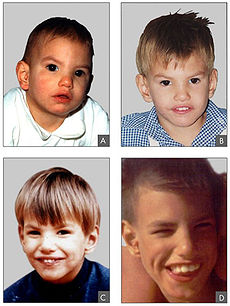- Cri du chat
-
Cri du chat or Cri-du-chat Classification and external resources 
Facial features of a patient with Cri du Chat syndrome at age of 8 months (A), 2 years (B), 4 years (C) and 9 years (D)ICD-10 Q93.4 ICD-9 758.31 OMIM 123450 DiseasesDB 29133 MedlinePlus 001593 eMedicine ped/504 Cri du chat syndrome, also known as chromosome 5p deletion syndrome, 5p minus syndrome or Lejeune’s syndrome, is a rare genetic disorder due to a missing part of chromosome 5. Its name is a French term (cat-cry or call of the cat) referring to the characteristic cat-like cry of affected children. It was first described by Jérôme Lejeune in 1963.[1] The condition affects an estimated 1 in 50,000 live births, strikes all ethnicities, and is more common in females by a 4:3 ratio.[2]
Contents
Signs and symptoms
The syndrome gets its name from the characteristic cry of affected infants, which is similar to that of a meowing kitten, due to problems with the larynx and nervous system. About 1/3 of children lose the cry by age 2. Other symptoms of cri du chat syndrome may include:
- feeding problems because of difficulty swallowing and sucking.
- low birth weight and poor growth.
- severe cognitive, speech, and motor delays.
- behavioral problems such as hyperactivity, aggression, tantrums, and repetitive movements.
- unusual facial features which may change over time.
- excessive drooling.
- constipation.
Other common findings include hypotonia, microcephaly, growth retardation, a round face with full cheeks, hypertelorism, epicanthal folds, down-slanting palpebral fissures, strabismus, flat nasal bridge, down-turned mouth, micrognathia, low-set ears, short fingers, single palmar creases, and cardiac defects (e.g., ventricular septal defect [VSD], atrial septal defect [ASD], patent ductus arteriosus [PDA], tetralogy of Fallot). People with Cri du chat are fertile and can reproduce.
Less frequently encountered findings include cleft lip and palate, preauricular tags and fistulas, thymic dysplasia, intestinal malrotation, megacolon, inguinal hernia, dislocated hips, cryptorchidism, hypospadias, rare renal malformations (e.g., horseshoe kidneys, renal ectopia or agenesis, hydronephrosis), clinodactyly of the fifth fingers, talipes equinovarus, pes planus, syndactyly of the second and third fingers and toes, oligosyndactyly, and hyperextensible joints. The syndrome may also include various dermatoglyphics, including transverse flexion creases, distal axial triradius, increased whorls and arches on digits, and a single palmar crease.
Late childhood and adolescence findings include significant intellectual disability, microcephaly, coarsening of facial features, prominent supraorbital ridges, deep-set eyes, hypoplastic nasal bridge, severe malocclusion, and scoliosis.
Affected females reach puberty, develop secondary sex characteristics, and menstruate at the usual time. The genital tract is usually normal in females except for a report of a bicornuate uterus. In males, testes are often small, but spermatogenesis is thought to be normal.
Genetics
Cri du chat syndrome is due to a partial deletion of the short arm of chromosome number 5, also called "5p monosomy". Approximately 90% of cases results from a sporadic, or randomly-occurring, de novo deletion. The remaining 10-15% are due to unequal segregation of a parental balanced translocation where the 5p monosomy is often accompanied by a trisomic portion of the genome. These individuals may have more severe disease than those with isolated monosomy of 5p.
Most cases involve total loss of the most distant 20-10% of the material on the short arm. Fewer than 10% of cases have other rare cytogenetic aberrations (e.g., interstitial deletions, mosaicisms, rings and de novo translocations). The deleted chromosome 5 is paternal in origin in about 80% of de novo cases.
Loss of a small region in band 5p15.2 (cri du chat critical region) correlates with all the clinical features of the syndrome with the exception of the catlike cry, which maps to band 5p15.3 (catlike critical region). The results suggest that 2 noncontiguous critical regions contain genes involved in this condition's etiology. Two genes in these regions, Semaphorine F (SEMA5A) and delta catenin (CTNND2), are potentially involved in cerebral development. The deletion of the telomerase reverse transcriptase (hTERT) gene localized in 5p15.33 may contribute to the phenotypic changes in cri du chat syndrome as well.
Diagnosis and management
Diagnosis is based on the distinctive cry and accompanying physical problems. Genetic counseling and genetic testing may be offered to families with individuals who have cri du chat syndrome. Prenatally the deletion of the Cri du chat related region in the p arm of chromosome 5 can be detected from amniotic fluid or chronionic villi samples with BACs-on-Beads technology. Children may be treated by speech, sound, and occupational therapists. Cardiac abnormalities often require surgical correction.
References
- ^ Lejeune J, Lafourcade J, Berger R, et al. (1963). "[3 Cases of partial deletion of the short arm of chromosome 5]" (in French). C. R. Hebd. Seances Acad. Sci. 257: 3098–102. PMID 14095841.
- ^ ped/504 at eMedicine
External links
- Spanish Support Group
- Australian Support Group
- United States Support Group
- United Kingdom Support Group
- A documentation in word and pictures: 24 years of living with the cri du chat-syndrome
Categories:- Autosomal monosomies and deletions
- Rare diseases
- Syndromes
Wikimedia Foundation. 2010.
